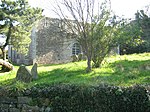Tristan Island

Tristan Island or the Île Tristan is located at the mouth of the Pouldavid Estuary off the French port of Douarnenez in south-western Brittany. It is only about 450 m long and 250 m wide but despite its small size, it has a rich history, especially since the Middle Ages when a priory was built there. In the 19th century, it became famous as the site of the first canning factory for sardines fished in the Bay of Douarnenez. It is also closely associated with Breton legends and the island of Ys. Now uninhabited, the island has become a nature reserve which is only accessible to tourists once or twice a year or by special arrangement with the local tourist office. At low tide, the island is connected to the mainland on the Douarnenez (or eastern) side of the estuary.
History
Tristan bears traces of civilization dating back to the Bronze Age. The written history of the island begins around 1118 when, according to a charter dated 1126,[1] Robert de Locuvan, bishop of Cornouaille, donated the Island of St Tutuarn and the lands belonging to it to the Abbey of Marmoutier. As a result, a priory was built on the island. It is interesting to note that Douarnenez is Breton for the land of the island as it was indeed the priory which owned the site on which the town was later built. In the 14th century, the island became known as Tristan. One of the most colourful figures associated with Tristan was Guy Éder de la Fontenelle, a rebel-bandit who took possession of the island in 1595, stationed his garrison of some 700 soldiers there, and proceeded to plunder most of the surrounding towns and villages.
After the island was acquired by Gustave le Guillou de Penanros in 1854, Vauban constructed several defensive buildings. In the southern part of the island, La Planche built a sardine press. Le Guillou de Penanros went on to develop the harbour and the sardine processing plant on the island, the first of the kind in what was to become Douarnenez' principal area of activity in the 19th and early 20th centuries. In 1911, the island was purchased by Jacques Richepin, an author and playwright, who built the rotunda and the Chapelle des Aviateurs commemorating the first transatlantic flight from Europe to the United States by Dieudonné Costes and Maurice Bellonte in September 1930.[2] In 1995, the island was bought by Conservatoire du Littoral which has carried out restoration work on the buildings and maintained the paths and gardens.
Landscape
The small island not only has rocky coasts and sea cliffs but also boasts an orchard, a tropical garden and several footpaths which reveal stunning views of the Bay as well as Treboul and Port Rhu on the mainland. At the northern end of the island, a lighthouse and the ruins of an old fort can be seen.
Fauna and flora
Rabbits and lizards abound on the island as do a wide variety of seabirds, especially cormorants, guillemots and herons. The vegetation is particularly rich in magnolias, medlars and quince trees. Cedars, oak and apple trees can also be seen as well as exotic varieties of bamboo, myrtle and mimosa. There is a large orchard in the southern part of the island as well as a tropical garden with a giant bamboo plantation, magnolia and fuchsia.
Offices for the Marine Park
The recently renovated canning factory is now used as offices for staff working for the Iroise Marine Park or Parc naturel marin d'Iroise created in 2007.[3]
Gallery
-
The Aviators' Chapel
-
Former canning factory
-
The north coast
-
The fort
External links
- Conservatoire du littoral, Bretagne, Ile Tristan
- Le phare de l'île Tristan, Bretagne.com
- Description of Ile Tristan from the official Douarnenez website
- Tristan Island from Google Maps




